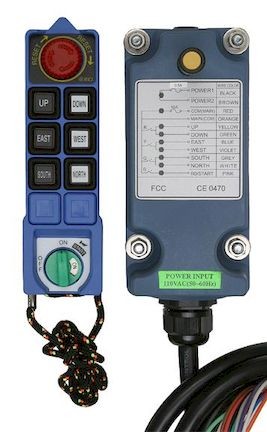Overhead Crane Radio Remote Control 260 Series 3 Motion 1 Speed
System includes Two Remotes and One Receiver with 6ft pigtail and two protective vinyl remote covers.
6 pushbuttons with 1-step (Up, Down, East, West, North, South) + EMS + Start Key
Regular Price: $1,180.00
Special Price $1,032.50
260 Series 3 Motion Single Speed Overhead Crane Remote Control System
260 Series of Radio Controls are ideal for smaller, simpler operations such as light-duty cranes and monorails. The 260 Series Radio Control has 1-step pushbuttons for three motions. This wireless control systems operate on exceptionally low power consumption providing up to three months of service on two AA batteries for the remote. The system features a user-friendly design, and simple useres manual. Operating range for the remote system is 300+ feet.
System includes Two Remote and One Receiver with 6ft pigtail
6 pushbuttons with 1-step (Up, Down, East, West, North, South) + EMS + Start Key
General Specifications
- Durable, robust IP 65 industrial casing
- New lightweight (250g) user friendly design
- Advanced RF circuitry design with over 4 billion ID codes
- Exceptionally low Power Consumption - up to 3 months usage with 2 AA batteries
- Error free Hamming code technology
- Working temperature range from -45° to +80°C
- Long distance operation up to 100m
- Purposely designed for the control of high-vibration, heavy-duty mobile and industrial equipment
- Remote ID Setting Technology allowing for instant maintenance at site
- Optional receiver input power. 48/110, 48/200, 110/220, 220/380 VAC & 12-24V DC. Ships standard with 110 VAC.
| Weight | 6 |
|---|---|
| Freight Status | Ships by UPS |
| Manufacturer | InMotion Controls |
| Manufacturer Part Number | ICI-260-System |
| Number Of Buttons | 6 Button |
| Pendant Motion | 3 Motion |
| Pendant Speeds | One Speed |
| Download Product Manual | N/A |
| Product Brochure | N/A |
Jib cranes are the most cost effective and versatile type of lifting equipment. They are great for use in production lines to keep machining cells, workstations and warehouse production moving. Jib cranes also work well to aid larger overhead crane systems. Jib cranes are easy to install and cost effective, with less structural limitations than other material handling options.
Follow these basic guidelines to help you choose the correct jib crane for your application:
Capacity: Choose a capacity that is right for current and future lifting needs. Most of the available options at JibCranes.com, up to 5 tons, include a 15% allowance for the hoisting equipment. This allows for full use of the rated jib crane capacity.
Span: Choose a span that is adequate to cover the full work area. Keep in mind that hoist and trolley selection may reduce the end approach, limiting hook coverage and requiring a move to a larger span.
Hook Height: The hook height is the height needed to lift your material. This measurement is equal to height under boom minus the headroom of the hoist and trolley.
Rotation: Jib cranes, depending on their design, have between 180° and 360° of rotation. Be sure that the area of installation is free of obstructions throughout the full range of rotation. Rotation stops are available upon request to limit the range of rotation.
Supporting Structure: When selecting a jib crane be sure to take into consideration the supporting structure. Building structures must be able to support the forces of the jib crane and load. Please, consult with your building designer or an engineer if uncertain of the adequacy of supporting structures. Also, keep in mind that the foundation requirements of freestanding jib cranes will add additional costs.





